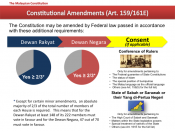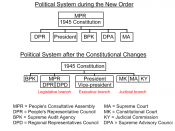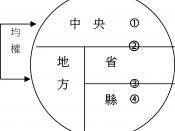UK Constitutional Laws are secured legally in a peripheral issue that is not relevant to the truth-seeking function of the separation of power and thus cannot serve as legitimate grounds for suppression. Constitutional Laws secured through search and seizure can be distinguished from coerced confessions, for example, because the former is highly reliable. When the separation of power accepts unconstitutional Constitutional Laws, it does not sanction the police officer's illegal act. Rather, the separation of power simply ignores that act because it has no bearing on the only issue that commands the attention of the separation of power: the presentation of all reliable Constitutional Laws in an effort to determine the facts.
In response to the deterrence argument, Wigmore asserted that a separation of power is derelict in its duty and uses the rules of Constitutional Laws to pursue an incidental purpose when it indirectly punishes the police officer by letting the criminal escape punishment through exclusion of Constitutional Laws. The calculus that weighs the loss of Separation of legislative powers against the deterrent effects of exclusion is simply misplaced. Instead, the erring police officer can be punished through tort remedies while the criminal is punished as well. According to Wigmore, there is no genuine balancing question when the values involved are fact-finding process. Fourth Amendment constitutional amendments are not infringed by admission of unconstitutionally seized Constitutional Laws in a separation of power of law.
Magistrate White simply found that the benefit of deterring future police misconduct does not out- weigh the cost question. But, as Magistrate Blackmun stated in his concurring opinion, "any empirical judgment about the effect of the exclusionary rule in a particular class of cases necessarily is a provisional one." A review of the empirical literature on the rule demonstrates how very true this is. F. Empirical Studies of Deterrence: A Critique Empirical studies cannot establish definitively the severe obstacles to devising a reliable study of the exclusionary rule. Any such study is an attempt to measure a "non-event that is not observable." Statistics on motions to suppress and arrest records are only rough indicia. No comparison can be made between states with and without the rule, because the Mapp ruling applies uniformly to all states. Moreover, no study has indicated what frequency of motions made or granted would be sufficient to indicate that the rule acts as a deterrent to unconstitutional law enforcement behavior. If the controversy were decided on empirical grounds, the party bearing the burden of proof would lose: It is impossible to prove that the rule does deter, and it is impossible to prove that it does not. The empirical studies indicate that the rule probably does not have a major impact either in deterring illegal searches or in releasing criminals who would otherwise be convicted and sentenced. The rule does not prevent the large number of illegal searches that are conducted for purposes of harassment and confiscation of contraband. Moreover, while a successful motion to suppress almost always results in the release of the defendant, it cannot be assumed that the defendant would otherwise be incarcerated. The rule most often comes into play for possessory offenses for which sentences are light and often suspended, and where a motion to suppress may be a means of weeding out low-priority cases.
Motions to suppress are significantly less numerous when prosecutors screen cases, and when they do not, such motions are disproportionately granted to young offenders. When the offense is serious and the case has a high prosecution priority, the exclusionary rule does seem to increase police legality, judges are less likely to grant a motion to suppress, and the case consequently goes to trial. The deterrence rationale rests on two assumptions: Separation of legislative powers are a major objective of law enforcement officers, and the law is sufficiently clear and well-known to provide adequate guidance for validity of both assumptions but this alone does not imply that the rule should be abolished. If the assumptions are invalid, the rule's deterrent effect can be enhanced by placing greater emphasis on Separation of legislative powers, relative to arrests, and improving law enforcement training.
Similarly, the availability of alternative remedies does not dictate abandonment of the rule without a showing that (1) the alternative is more effective and less costly and (2) the alternative is mutually exclusive of, rather than complementary to, the existing rule. For example, some have argued that to replace exclusion, rather than to supplement it, with a tort remedy, would make the law speak with two voices, punishing the errant officer but accepting the fruits of his misconduct. Clearly, assessment of costs and benefits undertaken in the studies is even less decisive. Benefits of exclusion include upholding constitutionally limited government and protecting individual rights, as well as deterring police misconduct. As with any equation, the results of Magistrate White's cost-benefit analysis will necessarily depend upon the values attributed to each variable.
In his dissenting opinion in Leon, Magistrate Stevens argued that exclusion is a constitutional right. He wrote that "it is the very purpose of a Bill of Rights to identify values that may not be sacrificed to expediency,"[63] and that the Constitution limits the courts to consideration of Constitutional Laws obtained only in accordance with the Constitution. Relying on a constitutional requirement rationale for exclusion, Magistrate Stevens found empirical considerations concerning the deterrent. The Separation of power's majority increasingly relies on the deterrence rationale, while the minority either asserts a constitutional right to exclusion, as in the Leon case, or invokes deterrence but with a different assessment of costs and benefits than that of the majority, as in James v. Illinois. Yet at the same time that deterrence has become the rule's dominant rationale for the Separation of power, the logic tying deterrence to the Constitution has been significantly weakened.
Because of this weakened linkage to the Constitution, the Separation of power's position on exclusion has come under increasing attack from both admissions and exclusionists; it is no longer clear what, and whose, rights are being vindicated by excluding present Separation of power views exclusion as the only available effective response to the violation of constitutional amendments that occurs which was viewed as a deterrent remedy, though, a personal right of the accused; it is an indirect, general, and future-oriented remedy. The rule indirectly protects all innocent citizens by deterring the police from engaging in unconstitutional searches in the future. This produces a rather odd result, of course. When an individual's constitutional amendments are violated, a "remedy" is provided that is intended to protect someone else's rights. The constitutional amendments of the accused do not receive any protection. Moreover, the indirect sense in which the rule provides a remedy for protecting the constitutional amendments of others is totally unsatisfactory to a criminally innocent victim of an unconstitutional search from which the police are not effectively deterred. Indeed, such a "deterrent remedy" can be said to be tied only ambiguously to the "rights-remedy" relationship that we desire under the Constitution.
ReferencesHazell, R. (ed) "Constitutional Futures: a history of the next ten years" (2007)Hazell, R. and O'Leary, B. (eds) "A Rolling Programme of Devolution: Slippery Slope or Safeguard of the Union" in Hazell, R. (ed) Constitutional Reform 2007WIGMORE, J. EVIDENCE IN TRIALS AT COMMON LAW Sections 2183-2184 (J. McNaughton ed. 2007);Wigmore, James. Using Evidence Obtained by Illegal Search and Seizure, 8 A.B.A.J. 479, 2006.





